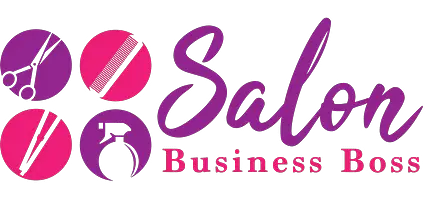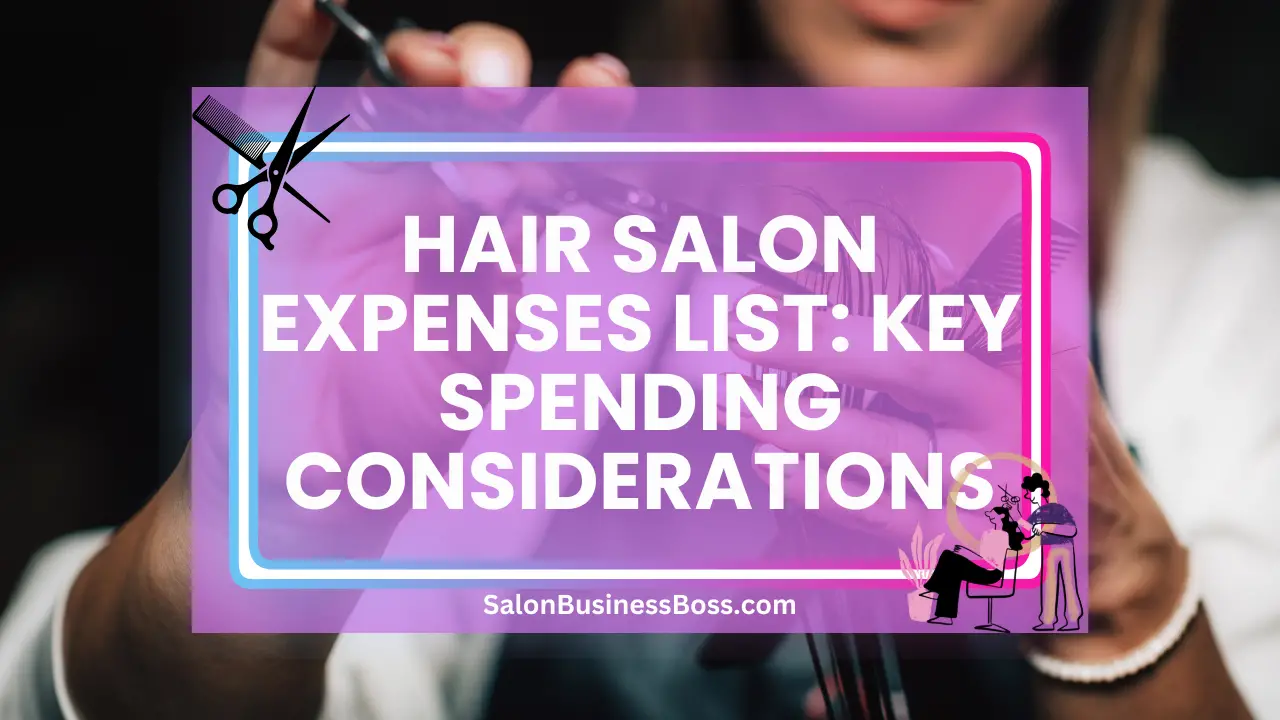Operating a hair salon involves numerous costs, ranging from day-to-day essentials to long-term investments. Salon owners must meticulously manage their expenses to ensure profitability and maintain high-quality services for their clients.
Hair salon expenses list includes rent/lease for the salon space, equipment purchases, furniture and décor, employee salaries, utilities, product inventory, insurance, marketing, taxes, loan repayments, software, and seasonal adjustments. Proper budgeting ensures financial stability and enables salon owners to invest in growth and excellence.
1. Initial Setup Costs
a. Salon Space Rent/Lease
One of the most significant expenses for a hair salon is the rental or lease cost for the salon space. The location, size, and amenities of the space directly influence the rent, making careful consideration essential to strike the right balance between cost and foot traffic. A well-located salon with high foot traffic may attract more clients but could come with a higher rental cost. On the other hand, a more affordable space in a less busy area might require additional marketing efforts to attract customers. Salon owners should thoroughly assess their budget, business goals, and target clientele when choosing a suitable space to ensure long-term profitability and success.
b. Salon Equipment
Investing in high-quality salon equipment is crucial for providing top-notch services and ensuring client satisfaction. The range of essential equipment includes styling chairs, washbasins, hairdryers, styling tools, and more. While the initial investment in equipment can be significant, it is essential not to compromise on quality as it directly impacts the salon’s reputation and efficiency. Researching and comparing prices from different suppliers can help salon owners save costs without sacrificing quality. Additionally, considering warranties, maintenance agreements, and durability can contribute to the equipment’s longevity, reducing the need for frequent replacements and repair expenses over time.
c. Salon Furniture and Décor
Creating a warm and inviting ambiance is a vital aspect of attracting and retaining clients. Salon owners must budget for salon furniture, reception area setup, and décor during the initial setup phase. Comfortable and stylish furniture not only enhances the overall client experience but also contributes to a positive brand image. The reception area should be well-designed to provide a pleasant first impression, while the salon’s overall décor should align with the brand’s theme or style. Cost-effective yet aesthetically appealing options can be explored to create an inviting atmosphere that keeps clients coming back for more.
d. Licensing and Permits
Complying with local regulations is essential for operating a hair salon legally and avoiding potential legal issues. This involves obtaining the necessary business licenses and permits, which may come with additional fees. The specific licenses and permits required vary depending on the salon’s location and the services offered. Salon owners should research and communicate with local authorities to understand the specific requirements and associated costs. While it may seem like an added expense, ensuring compliance not only prevents legal troubles but also helps build trust with clients, who appreciate knowing they are receiving services from a fully licensed and authorized establishment.
2. Ongoing Salon Overheads
a. Employee Salaries and Benefits

Payroll expenses, including salaries for stylists and receptionists, play a pivotal role in the success of a hair salon. Attracting and retaining skilled staff relies on offering competitive wages and benefits. Alongside competitive salaries, benefits such as health insurance, paid time off, and retirement plans are attractive incentives that contribute to employee satisfaction and loyalty. A happy and motivated team ensures a positive salon atmosphere and enhances customer experience. Striking the right balance between salaries and benefits within the salon’s budget is essential for financial sustainability while fostering a productive and content workforce.
Read more about: How to Maintain a Beauty Salon and Make it Profitable
b. Utilities
Utilities are vital operational costs that should be budgeted to avoid unexpected financial burdens. These expenses include electricity, water, heating, and cooling. Properly managing energy consumption and investing in energy-efficient appliances can help reduce utility costs over time. Salon owners should closely monitor these expenses and consider implementing cost-saving measures, such as LED lighting, programmable thermostats, and efficient water fixtures, to keep utility bills in check without compromising on client comfort.
c. Product Inventory
A well-stocked product inventory is fundamental to meeting client demands and offering a diverse range of services. Regularly assessing inventory levels helps prevent overstocking, which can lead to wastage and tie up valuable capital. Implementing an inventory management system can optimize purchasing by accurately tracking product usage and reordering patterns. Collaborating with suppliers for discounts on bulk purchases is also a cost-effective strategy. By maintaining a balanced and well-managed inventory, salon owners can minimize unnecessary expenses and maximize profits.
d. Cleaning and Maintenance
Maintaining a clean and hygienic environment is critical for the health and safety of both clients and staff. Regular cleaning, equipment maintenance, and timely repairs are essential to uphold the salon’s reputation and create a positive impression. Neglecting maintenance can lead to costly breakdowns or potential hazards, affecting the overall client experience. Scheduling routine maintenance and investing in durable equipment can reduce the frequency of repairs and extend the lifespan of salon assets, ultimately saving on long-term expenses.
e. Insurance
Insurance coverage is an indispensable aspect of safeguarding the salon against unforeseen events and potential lawsuits. Salon owners should consider liability insurance to protect against accidents or injuries on the premises, property insurance to cover any damage or loss, and worker’s compensation insurance to provide financial support to employees in case of work-related injuries. While insurance premiums represent regular expenses, they offer peace of mind and financial protection, ensuring the salon can withstand unexpected challenges without suffering severe financial setbacks.
f. Software and Technology:
Investing in salon management software, appointment booking systems, and point-of-sale solutions can significantly streamline operations and enhance efficiency. While these technological solutions come with associated costs, they ultimately save time and money by automating administrative tasks and improving client management. Salon software facilitates appointment scheduling, client databases, inventory tracking, and financial reporting, allowing salon owners to make data-driven decisions and optimize resource allocation.
g. Marketing and Advertising
Allocating funds for marketing campaigns, social media advertising, and promotional materials is essential for attracting new clients and retaining existing ones. Effective marketing strategies help create brand awareness, build a loyal customer base, and drive salon revenue. Salon owners should carefully plan their marketing budget, leveraging both online and offline channels to reach their target audience effectively. Measuring the return on investment (ROI) of different marketing efforts allows for refining strategies and optimizing budget allocation to maximize their impact on salon growth and success.
3. Employee Training and Education
a. Continuing Education
In the fast-paced and ever-evolving beauty industry, continuing education is vital for salon staff to stay updated on the latest trends, techniques, and product innovations. Salon owners should prioritize budgeting for ongoing training and workshops to provide their employees with opportunities to expand their skillsets and knowledge. By investing in continuing education, salon staff can offer cutting-edge services to clients, ensuring their satisfaction and loyalty. Moreover, well-trained stylists are more confident and efficient, contributing to the overall success of the salon. Regularly attending seminars, webinars, and industry events fosters a culture of growth and professionalism within the salon, positioning it as a go-to destination for the latest and most innovative hair treatments.
b. Professional Development
Encouraging professional development among salon employees is a proactive approach to nurturing talent and promoting career growth. Salon owners should create an environment that fosters learning and skill enhancement, providing opportunities for employees to attend conferences, obtain certifications, and participate in skill-building programs. As staff members gain expertise and refine their techniques, the quality of services offered improves, leading to increased client satisfaction and positive word-of-mouth referrals. Professional development initiatives also boost employee morale and job satisfaction, contributing to higher retention rates and a stronger team bond. By investing in the growth of their employees, salon owners create a dynamic and competitive workforce that elevates the salon’s reputation as a hub for exceptional and forward-thinking hair services.
4. Taxes
a. Income Taxes

Salon owners are required to allocate a portion of their revenue to cover income taxes imposed by federal, state, and local governments. Calculating income taxes involves considering various factors such as total revenue, allowable deductions, and applicable tax rates. It is essential for salon owners to maintain accurate and organized financial records to ensure compliance with tax regulations and to accurately report their income. Failing to allocate funds for income taxes can lead to financial difficulties and potential penalties. Seeking the advice of a tax professional can help salon owners navigate the complexities of tax laws and optimize their tax planning, ensuring that they meet their tax obligations while maximizing deductions and minimizing tax liabilities.
Read more about: Hairstylist Tax Deduction Checklist
b. Sales Taxes
In areas where sales taxes are levied on goods and services, salon owners must account for these taxes in the pricing of their services. Sales taxes are typically collected from the clients at the point of purchase, and salon owners are responsible for remitting these taxes to the relevant tax authorities. Failing to include sales taxes in the service prices can result in financial strain for the salon, as the salon would have to cover the tax amount out of its own revenue. Implementing a proper point-of-sale system that automatically calculates and adds the applicable sales taxes to the final bill can help streamline the process and ensure compliance with sales tax regulations. Accurate reporting and timely remittance of sales taxes are crucial to avoid penalties and maintain the salon’s financial health.
5. Loan Repayments and Interest
If the salon was funded through loans or credit lines, it is crucial to allocate funds for regular repayments and interest to maintain a healthy financial status. Meeting loan obligations on time not only preserves the salon’s creditworthiness but also avoids penalties and additional interest charges. Careful budgeting should account for the fixed loan repayments and the varying interest amounts, allowing salon owners to plan their cash flow effectively and avoid any cash flow shortages. Timely loan repayments demonstrate responsible financial management and build trust with lenders, which can be beneficial for future financing needs and negotiating better terms.
6. Salon Software and Technology
a. Investing in user-friendly salon management software with robust features is a wise decision for streamlining salon operations. Such software offers benefits like efficient appointment scheduling, maintaining a comprehensive client database, tracking inventory levels to avoid stockouts, and generating financial reports for better financial decision-making. Automating these tasks through software improves efficiency, reduces administrative burdens, and frees up time for staff to focus on providing excellent services.
b. Salon technology provides valuable insights through data analysis, enabling data-driven decisions. Analytics can identify popular services, peak hours, and client preferences, helping salon owners tailor their offerings to meet customer demand effectively. By leveraging technology to optimize operations, salon owners can enhance client satisfaction, increase profitability, and stay ahead of competitors.
7. Promotional Offers and Loyalty Programs
a. Offering promotional discounts and loyalty programs can be effective strategies to attract new clients and retain existing ones. However, salon owners must carefully assess the cost of these incentives. Setting appropriate discounts and rewards is essential to ensure that promotional offers do not eat into the salon’s profitability. Calculating the return on investment (ROI) of promotional campaigns helps determine their effectiveness and whether adjustments are necessary.
b. Monitoring the success of these offers through customer feedback and tracking the number of repeat visits from loyalty program members enables salon owners to fine-tune their promotions. Targeted and well-timed promotional campaigns can bolster client loyalty, encourage word-of-mouth referrals, and ultimately contribute to increased revenue.
8. Seasonal Expenses

a. Seasonal fluctuations in demand are common in the salon industry, and salon owners must prepare accordingly. Adjusting staffing levels to match peak and off-peak periods ensures optimal employee utilization and cost control. Maintaining an appropriate level of inventory during busy seasons prevents stock outs and missed opportunities for revenue.
b. Holiday promotions and special events during busy seasons can attract more clients, but the budget should account for the additional expenses associated with these promotions. Allocating resources strategically ensures that seasonal offerings align with the salon’s financial goals and deliver a positive impact on the bottom line. Flexibility and adaptability in managing seasonal expenses contribute to a successful and financially resilient salon business.
Read more about: Hair Goals, Business Gains: Starting Your Journey
Conclusion
Effectively managing hair salon expenses is crucial for sustainable growth and success in a competitive industry. By understanding and organizing the various costs involved, salon owners can make informed decisions, optimize resources, and provide exceptional services to their clients. A well-planned budget not only ensures financial stability but also allows salon owners to invest in continuous improvement and stand out in the market as a beacon of excellence.
Frequently Asked Questions

1. What should be included in the salon employee training budget?
Set aside funds for continuing education, workshops, and professional development programs to enhance the skills of your salon staff.
2. What taxes do I need to account for as a salon owner?
As a salon owner, you need to account for income taxes, both federal and state, as well as sales taxes if applicable in your area.
3. How can I manage loan repayments and interest effectively?
Budget for regular loan repayments and factor in interest costs to ensure you meet your financial obligations promptly.
To learn more on how to start you own salon checkout my startup documents here.
Please note that the contents of this blog are for informational and entertainment purposes only and should not be construed as legal advice. Any action taken based on the information provided in this blog is solely at your own risk. Additionally, all images used in this blog are generated under the CC0 license of Creative Commons, which means they are free to use for any purpose without attribution.

About the author. Entrepreneur and Salon Business Fan.
Hi! I am Shawn and I am a happy individual who happens to be an entrepreneur. I have owned several types of businesses in my life from a coffee shop to an import and export business to an online review business plus a few more and now I create online salon business resources for those interested in starting new ventures. It’s demanding work but I love it. I do it for those passionate about their business and their goals. That’s why when I meet a salon business owner, I see myself. I know how hard the struggle is to retain clients, find good employees and keep the business growing all while trying to stay competitive.
That’s why I created Salon Business Boss: I want to help salon business owners like you build a thriving business that brings you endless joy and supports your ideal lifestyle.

